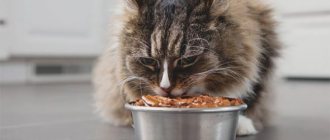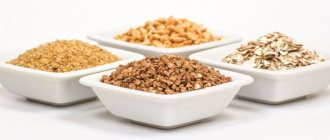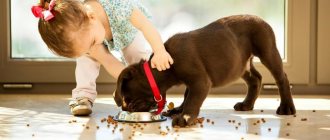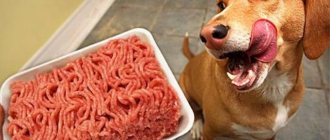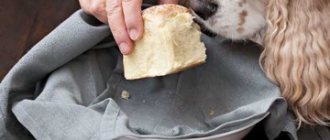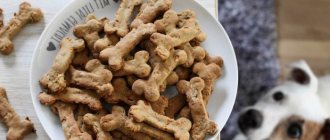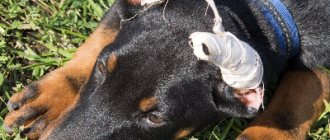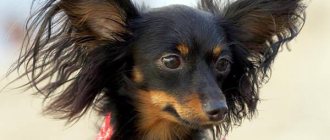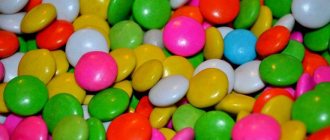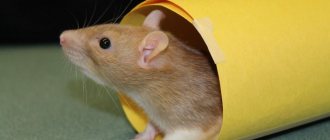In many ways, the health and longevity of a dog depends on proper nutrition. An incorrectly designed diet can lead to both obesity and exhaustion. Many breeders know how to deal with the first problem. But not everyone knows how to gain weight for a dog. Therefore, it will be useful to cover this issue in more detail.
Unfortunately, this happens quite often.
Causes of weight loss
Alas, the most common reason is a simple lack of food. Dogs picked up by kind people on the streets are simply starving and because of this they can barely move their paws. Having taken a stray dog from the street, it is very important to help him quickly gain weight by ensuring proper fattening.
Another common cause is illness. In some cases, it affects the gastrointestinal tract, and the pet simply cannot eat normally or digest food. In other cases, due to illness or associated pain, the animal loses its appetite and rapidly loses weight.
Parasites deserve special mention.
They suck all the juices out of the unfortunate dog - he actively eats and still quickly loses weight. Important! Thinness should not be confused with natural conformation - for example, many greyhounds and some other dog breeds are, in principle, very thin - this is the norm for them.
Moreover, these are dogs whose light weight helps them develop high speed and maintain this pace for a long time. In addition, the following problems lead to exhaustion:
- simultaneous rearing of 10 or more puppies by one bitch,
- old age,
- dysbiosis.
Finally, we must not forget about improper distribution of food. For example, if several animals live in an apartment, then the largest dog can drive away less aggressive brothers and eat their food. Of course, he will actively gain weight, and they will lose weight. To prevent this from happening, it is necessary to monitor your pets during feeding.
Visiting the veterinarian
Finally, remember that different dog breeds often have different ideal weights and body shapes. For example, a Greyhound will always look slimmer than a Labrador Retriever. However, the best thing you can do if you are concerned about your pet's weight is to take it to a veterinarian. They will give you the best advice regarding the breed and health of your dog. When visiting the veterinarian, it is recommended to bring :
- Record their weight loss if you weighed them regularly;
- The packaging of any meals and treats you give them, as well as how often you offer them that food;
- Record any potential additional symptoms;
- Recording how much they have eaten of the food you give them;
- Record their activities and exercises.
Author of the article : Olivia Williams .
Symptoms and signs of underweight
But it’s not enough to know why your dog isn’t gaining weight. It is equally important to be able to determine that it weighs less than it should.
In fact, the task is much easier to cope with than it might seem. Often one glance is enough to give the dog the correct diagnosis. Experts usually distinguish two phases of low body weight: underweight and dystrophy.
The first is associated with a sharp transition to the waist. The lumbar vertebrae, like the pelvic bones, are noticeable, but do not protrude too much. By palpating the ribs, you cannot feel healthy subcutaneous fat.
Dystrophy is an even more advanced stage. In this case, not only is there no fat reserve, but also muscle mass is lost. The bones protrude so much that the dog turns into a skeleton covered with skin, and often shabby.
In any case, it is necessary to take measures as quickly as possible to save the animal.
The dog went through a terrible ordeal
Vitamins for weight gain
In addition to a properly formulated diet, special vitamins can also help an exhausted dog gain weight. A pet's body always needs nutrients, many of which are not found in the animal's usual food. If the main goal is to gain weight for your pet by increasing muscle mass (the most acceptable option), then it is better to give preference to the following vitamin complexes:
- "Wolmar". The drug contains 18 amino acids, 12 vitamins and minerals that have a beneficial effect on the growth of muscle cells. The main task of this vitamin supplement is to activate protein synthesis in muscle tissue, which allows you to increase the total muscle mass, and therefore the weight of the animal. In addition, vitamins supply the dog’s body with the energy the pet needs during increased physical activity.
- "Protevit plus" - vitamins recommended to prevent metabolic disorders in the body. The drug contains protein, potassium, magnesium, linoleic acid, vitamin C, K, and a protein metabolism stimulator. All these components have a beneficial effect on all processes in the dog’s body, increasing the performance and endurance of the pet.
As in the case of the optimal food mixture, only a doctor can suggest the ideal type of vitamin supplements for a particular dog, based on the pet’s condition and the presence of any concomitant diseases.
We advise you to read more about the meaning and criteria for choosing vitamins for dogs.
Diagnostics
Also, before figuring out how to feed your dog so that it gains weight, you should conduct appropriate diagnostics.
As mentioned above, an animal can be thin for various reasons - oncology cannot be ruled out. Therefore, it is very important to contact the clinic immediately.
Here experts, using X-rays, ultrasound, stool, blood and urine tests, will be able to determine the cause of the disease as accurately as possible. For example, this could be a pathology of internal organs or helminthiasis. Based on this, nutrition will be adjusted - if necessary, in combination with taking appropriate medications.
Attention! Diagnostics is very important - if you do not eliminate the reason why the dog began to lose weight, you will not be able to cope with the problem - even the most healthy and high-calorie diet will not help.
Features of nutrition for recovery after illness
If the dog has simply been sick for a long time and now needs to be fattened, it is best to resort to regular high-calorie food. But it should be relatively liquid - the ideal choice would be porridge with a consistency similar to puree soup. On the one hand, they are easily digestible. On the other hand, they do not need to be chewed, expending additional energy.
It’s a little more difficult if the dog’s gastrointestinal tract is disrupted, for example, due to dysbiosis. She can eat actively, but still lose weight. Well, even the best food won't help here. First you need to restore the balance of bacteria. To do this, the dog needs to be actively fed fermented milk products - the best choice would be kefir, or even better - homemade yogurt. After a few days, the problem will be solved and the dog will quickly gain weight with a normal diet.
On a note! During fattening, you cannot combine meat with dairy products - calcium interferes with the absorption of iron. It is better to give them at intervals of several hours.
Nutrition for malnourished dogs
The diet must be balanced
Now it’s worth moving directly to the question of what to feed an emaciated dog to gain weight.
One of the main rules is small portions. You cannot give food like a healthy animal twice a day in large portions. No, in order to properly feed a pet, it needs to be given food 7-8 times a day, but little by little.
It is best to use natural food - here the person knows exactly what he is feeding the dog, and does not rely on the honesty of the dry food manufacturer. Moreover, the diet should contain a lot (about 70%) of meat to restore muscle mass. It is best to take low-fat and easily digestible varieties, such as chicken and rabbit.
The remaining 30% should be divided between cereals and vegetables - approximately 20-25 and 5-10%, respectively. It is best to choose rice and buckwheat from cereals, and carrots, zucchini and pumpkin from vegetables.
Attention! The porridge is cooked in meat broth (the proportion is 1 cup of cereal to 4-5 cups of liquid), the vegetables are chopped and mixed with it and meat. The result is a nourishing, tasty and healthy mixture.
Brief conclusions
Objectively assess your pet's condition. In the case when the ideal diet is chosen, the tests are clear and the animal feels cheerful, there is no need to panic right away. If other dog breeders consider your dog to be thin, this does not mean that the weight is falling. Carry out control weighing in the morning, find out the independent indicators and metrics of your breed. Change the food, combine dry food and natural food. And be sure to consult with professionals. Health to you and your four-legged friend!
When to fatten a dog
Of course, the most common situation when you need to feed a dog is exhaustion due to illness, pregnancy, difficult childbirth or hunger. But sometimes everything is not so critical. For example, if a purebred dog has a show on his nose, and he weighs a kilogram or even several hundred grams less than normal. This happens quite often, especially in active dogs like huskies or hunting dogs. They can be fed quite actively, and the pets still burn all the calories while playing and running around.
There is nothing complicated here - every dog breeder knows how to fatten a dog quickly. You just need to slightly increase the portions when feeding or add an additional hearty snack to lunch, and at the same time reduce physical activity. The key here is moderation. When adjusting the dog to the standard, it is important not to harm him - it will be very difficult to cope with obesity.
How to formulate a diet for fattening
To complete the picture, we should talk in more detail about some of the nuances associated with proper fattening of a dog.
Is it worth buying ready-made food?
Love and good nutrition work wonders.
You should immediately discard dry food - they are not digested very well or quickly, and moreover, this requires more energy. This is why experienced dog handlers recommend feeding natural food when exhausted.
If this is not possible, you can switch to canned food. The main thing is to ensure that they are of really high quality. True, they are not cheap - a quality product made from meat cannot be cheap.
Dietary supplements to help you gain weight
Many breeders, faced with the problem of dog exhaustion, use special supplements that will help them gain weight much faster. First of all this:
- Meat and bone meal is a source of proteins, phosphorus and calcium. The norm is 1-2 teaspoons per day, depending on the size of the dog.
- Fish oil - improves immunity, strengthens bones, protects against a number of diseases. Give once every 2-3 days.
- Seaweed is a source of a number of microelements, including iodine. Give from 50 to 150 grams of product per day.
- Plantain - perfectly improves the functioning of the intestines and stomach. In addition, it increases hemoglobin, which is very important in case of exhaustion. Grind, pour over boiling water and mix with porridge.
Such tricks allow you to quickly solve the problem and not harm the dog.
Weight gain on dry food
Special lines of dry food for weight gain by an emaciated dog are the best solution to this problem. The owner does not have to think about what kind of food and in what quantity should be given to the dog, and all that is needed is simply to calculate the daily weight of the finished food in accordance with the current condition of the pet.
The most popular types of such therapeutic nutrition include the following options for ready-made feed mixtures:
- Royal Canin Gastro Intestinal Dog. It is often used during the recovery period after illnesses and for anorexia in dogs. Contains rice, degenerative poultry proteins, egg powder, beet pulp, corn, animal fats. The constituent components ensure ease of digestion of the prepared food, without causing any negative consequences of its use on the part of the animal’s digestive system. The manufacturer produces dietary products for 20 different breeds, taking into account the individual characteristics of different dogs and their living conditions. Experts consider one of the significant disadvantages of this food to be the high content of ingredients of plant origin.
- Britcare. The main advantage of this premium food is the high content of meat as a source of protein and rice as a source of carbohydrates. Compared to wheat and corn, it is digested much better and does not cause food allergies in dogs prone to it. The disadvantage of this food is its low fiber content (only 2.5%).
- Happy dog Supreme Sport. A good solution for a balanced diet not only for sick and malnourished dogs, but also for animals facing daily physical stress. Poultry, rice flour and corn present in the food help replenish wasted energy and improve the overall well-being of the pet. According to the manufacturer, flavorings, food colors and preservatives are completely absent. At the same time, he did not indicate which types of meat were used in the production of this food, which, together with the high cost, is considered the main disadvantages of this option.
- Hill's Science Plan. In comparison with previous options, the undeniable advantages of this particular food are its low cost and high content of vitamins and minerals, although the exact amount of meat is not reported. Also of concern is the presence of corn and wheat as the main ingredients of ready-made food, and as you know, it is these cereals that are considered a serious allergen.
Important! You should not save on your pet’s health by buying cheap dry food from unknown companies. Ideally, you should choose food only after consulting a veterinarian, based on the dog’s current condition.
Failure to digest food, what to do
At the initial stages of rehabilitation, it is not recommended to feed an emaciated dog dry food. The optimal consistency of food is liquid or semi-liquid, because it is in this form that a weakened stomach absorbs it best. Problems with digestion usually occur when:
- excessive feeding of the animal;
- food intolerance to any constituent ingredients of food products;
- rapid swallowing of the offered food;
- spoilage of products;
- high content of cereals and lack of meat in the composition;
- helminthic infestations.
The main sign of a problem is vomiting, indigestion and the release of almost the entire amount of food eaten. In severe cases, body temperature may increase. Reviewing its diet and replacing the selected food mixture with a lighter option will help improve your pet’s well-being. You need to feed the dog in very small pieces, trying to prevent the swallowing of air along with the food.
Dosage of dry food when gaining weight
At first glance, everything seems extremely simple: in order for a dog to gain weight, you just need to increase the amount of food given, especially since the packaging of the finished product already contains manufacturer’s recommendations in this regard. However, if in some cases you can simply adhere to the upper limits of the noted norm, then in case of a large weight deficit, it is worth adding another 10–30% to this value, distributing the additional amount of granules between all feedings. If the resulting volume of food for a particular animal turns out to be too much, you can simply replace the standard feed mixture with a higher-calorie product: for example, food intended for growing puppies, pregnant or lactating bitches. To correctly measure the appropriate amount of food, it is advisable to use a special measuring cup, which is often included with the food itself.
Important! By increasing the caloric content of food, you should not limit physical activity. In the first weeks after the start of treatment, the animal does not have much strength, but in the future it is useful for him to walk, swim or even run.

